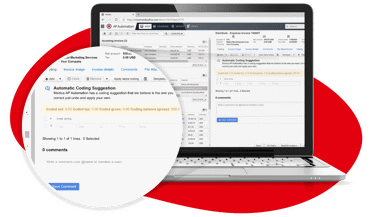How to set Accounts Payable goals using automation
The Accounts Payable (AP) department is a cornerstone of any organization's financial well-being, responsible for key objectives like timely vendor payments, accurate data maintenance, and fostering positive supplier relationships. In today's dynamic business landscape, AP is not just a functional unit but a strategic asset that can significantly influence an organization's financial health. Leveraging automation in this critical department not only streamlines tedious tasks but also transforms it into a powerhouse of efficiency and strategic advantage.

The evolving role of accounts payable
The AP department has undergone a significant transformation over the years. Once considered a back-office function, AP professionals are now at the forefront of financial operations. Automation has played a pivotal role in this shift, enabling AP teams to focus on strategic tasks like maintaining vendor relationships, optimizing cash flow, and contributing to data-driven decision-making.
Why setting AP goals is crucial
Clear, well-defined objectives can elevate the AP department from a mere cost center to a strategic asset. By aligning goals with broader organizational objectives and current economic conditions, AP teams can significantly improve both employee morale and the bottom line. This alignment ensures that AP objectives are not just about cutting costs but also about adding value to the organization.
Key metrics and KPIs for AP objectives
Understanding and tracking the right metrics and KPIs is crucial for measuring the success of your AP objectives. Below are some commonly used KPIs that provide a comprehensive view of AP performance.
-
Days Payable Outstanding (DPO)
DPO measures the average number of days it takes for an organization to pay its invoices from trade creditors. A lower DPO indicates quicker payments, which could be beneficial for vendor relationships but may also indicate a lack of cash management. Conversely, a higher DPO suggests that a company is taking longer to pay its bills, which could strain vendor relationships but may also mean better cash management. Balancing DPO is crucial for maintaining good vendor relationships while also optimizing cash flow.
-
Cost per Invoice
Cost per Invoice measures the total cost incurred by the AP department to process a single invoice. It includes the cost of labor, technology, and overheads. A lower Cost per Invoice is generally desirable as it indicates higher efficiency in the AP process. Automation can significantly reduce this cost by streamlining various AP tasks.
-
No-Touch Rate
The No-Touch Rate refers to the percentage of invoices that go through the AP process without requiring any manual intervention. A higher No-Touch Rate is generally indicative of a more efficient and automated AP process. It reduces the likelihood of human error and speeds up the invoice processing time, contributing to better vendor relationships and cost savings.
-
Invoice processing time
This KPI measures the average time taken to process an invoice from receipt to payment. A shorter invoice processing time is generally better, as it can lead to early payment discounts and improved vendor relationships. Automation can play a significant role in reducing invoice processing time by eliminating manual tasks.
-
Invoice Error Rate
The Invoice Error Rate measures the percentage of invoices that contain errors and require rework. A lower error rate is desirable as it indicates a more accurate and efficient accounts payable process. Automation can help reduce the error rate by automating data entry and validation processes, thereby reducing the scope for human error.
Integrating AP goals with broader business strategies
Effective accounts payable management, with well-set accounts payable objectives, goes beyond optimizing individual processes and aligns with broader financial and strategic goals. When setting accounts payable goals, it's crucial to consider how these objectives support and drive the broader business strategies.
Strategic alignment of AP objectives
Every goal set within the AP department should reflect and contribute to the overall business objectives. Whether it's improving cash flow, enhancing supplier relations, or driving innovation, AP goals should be a strategic component of your business's financial health and operational efficiency.
AP's role in business growth
Consider how objectives of accounts payable management, like optimizing payment terms, can positively impact cash flow, directly influencing your organization's ability to invest, grow, and adapt in a dynamic market.
The accounts payable function, when optimized through automation, plays a pivotal role in supporting and driving a company's growth goals. It's not just about managing invoices and payments efficiently; it's about enabling the business to scale and expand without being hindered by operational bottlenecks.
Take Huuskes, for instance, where manually handling 55,000 invoices yearly impeded growth. With Medius' solution, they transformed their AP processes, enhancing efficiency and paving the way for expansion. This shift allowed Huuskes to focus on scaling their business, unencumbered by manual AP tasks.
Learn more about Huuskes’ journey to business growth with Medius.
Collaboration across departments
Achieving effective AP objectives often requires collaboration with other departments, such as procurement and finance. Goals for accounts payable should therefore be established in conjunction with these teams to ensure a unified approach to managing company finances.
Measuring success beyond numbers
While metrics like 'cost per invoice' are important, also consider how your AP goals contribute to broader business outcomes, such as supplier satisfaction or operational agility. These qualitative measures are equally vital in assessing the success of your AP automation efforts.
Industry-specific accounts payable objectives
The objectives of accounts payable management can significantly differ based on industry-specific requirements and challenges. Tailoring your AP automation goals to align with these unique industry needs is crucial for achieving optimal efficiency and strategic value.
In manufacturing, for example, the focus might be on streamlining high-volume transactions and managing complex supply chains. Conversely, in the service sector, the emphasis could be on enhancing vendor relationships and managing contract-based payments.
Accounts payable automation solutions need to be adaptable to meet the diverse demands of different industries. For instance, in the manufacturing industry, where managing a high volume of transactions and complex supplier relationships is critical, an effective AP automation system should offer specialized features.
These might include robust invoice matching capabilities and integration with supply chain management systems. This functionality allows for seamless handling of bulk orders and intricate payment agreements, ensuring efficient, error-free processing in a high-stakes environment.
Such tailored automation solutions not only streamline industry-specific workflows but also ensure compliance with unique regulatory and operational standards.
Whether it's dealing with regulatory compliance in healthcare or handling international suppliers in retail, setting AP automation goals should involve an understanding of these sector-specific challenges and how automation can address them.
Involving stakeholders from different departments can provide insights into how AP automation can support industry-specific objectives. This collaborative approach ensures that the set goals are not only aligned with AP but also resonate with the broader industry context.
Employee training and adaptability
For an accounts payable manager, goals and objectives should include implementing AP automation and ensuring the team is well-trained to maximize the benefits of this technology. By equipping your AP staff with the necessary skills to adapt to new technologies, you can maximize the benefits of automation. This not only contributes to achieving AP objectives but also fosters a culture of continuous learning and improvement.
In addition to equipping your AP staff with the necessary skills for automation, it's essential to adopt a strategic approach to training. This could include structured onboarding programs for new software, regular workshops to update skills, and access to online resources for continuous learning. Encouraging a culture of adaptability and openness to change is key.
Consider highlighting success stories within your organization where team members have effectively utilized AP automation tools, turning these experiences into learning opportunities for others. This approach not only enhances the adoption of automation but also fosters a workplace environment that values growth and innovation.

Vendor relationship management
Healthy vendor relationships are crucial for any organization. Automation can significantly enhance this aspect of AP by ensuring timely payments and improving communication. This not only nurtures existing relationships but also opens the door to new opportunities, such as early payment discounts.
Also consider how features like real-time payment tracking and automated communication tools can transform interactions with suppliers. These tools can provide vendors with timely updates on invoice statuses, reducing inquiries and building trust. Additionally, automation enables more strategic vendor management, like analyzing payment terms to identify opportunities for early payment discounts or better payment terms.
By leveraging these features, businesses can not only maintain but also strengthen their vendor relationships, leading to potential collaborations and improved supply chain efficiency.
Cost reduction and ROI measurement
Cost reduction remains a primary goal for AP departments, aiming not just at cutting expenses but optimizing processes for efficiency. Automation plays a crucial role here, shifting the focus of AP teams from routine tasks to strategic initiatives like vendor negotiations, leading to meaningful cost savings.
Measuring the ROI of AP automation is key, involving factors like reduced processing times, lower error rates, and improved cash flow management. For instance, TOGA, a renowned property development and construction group, experienced a significant transformation with Medius’ solution. By automating their AP processes, TOGA reduced their invoice processing costs by 30%, showcasing the tangible financial benefits of automation.
Such real-world examples demonstrate that AP automation is not only about operational upgrades but also about strategic financial impact, offering long-term savings and efficiency gains.

Discover the detailed story of TOGA's success and the financial impact of AP automation. Read the full TOGA case study to learn more about their journey and results.
Realizing AP's strategic potential through automation
The role of AP automation in enhancing an organization's financial operations is clear and significant, especially when pursuing effective AP objectives with automation to achieve strategic and operational excellence. It goes beyond mere process improvement to fundamentally change how the AP department contributes to overall business goals.
From elevating the AP department's role to strategic heights to setting and achieving robust AP goals, automation is at the heart of modern financial operations. It empowers teams to not only manage invoices and payments efficiently but also contribute significantly to organizational growth and vendor relationship management. The adoption of AP automation thus emerges as a strategic necessity, driving cost reductions, enhancing operational agility, and enabling more informed decision-making.
Beyond the operational efficiencies, AP automation is a strategic catalyst for business growth, aligning accounts payable goals with broader business objectives. The case studies of Huuskes and TOGA exemplify how automation can revolutionize AP processes, leading to significant cost savings and enabling businesses to focus on expansion and strategic initiatives. These real-world successes underscore the vital role of AP automation.
Take the next step in AP automation with Medius

Are you ready to elevate your AP department into a strategic business partner? Medius offers innovative AP automation solutions that cater to your unique business needs. Our technology simplifies your AP processes, cuts costs, and arms you with the tools for strategic financial management and growth.
Discover how Medius can assist you in reaching your accounts payable goals and propel your business forward. Get in touch with Medius today or learn more about our AP automation solutions.






